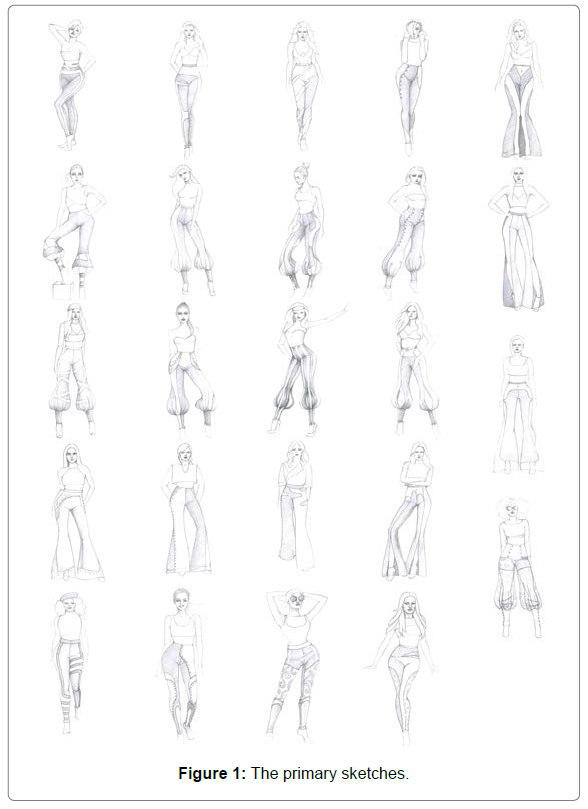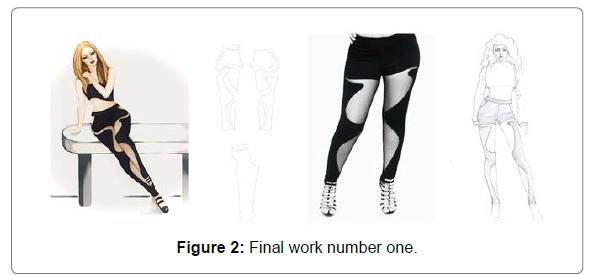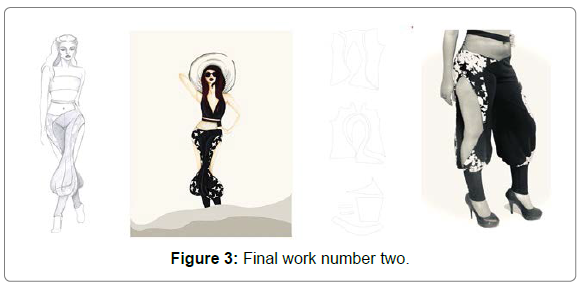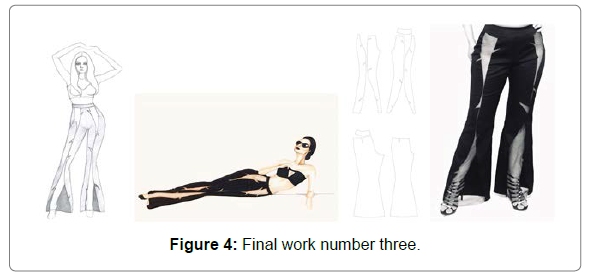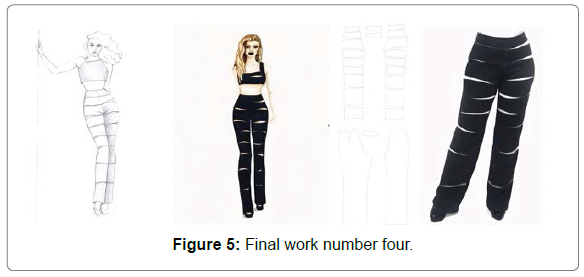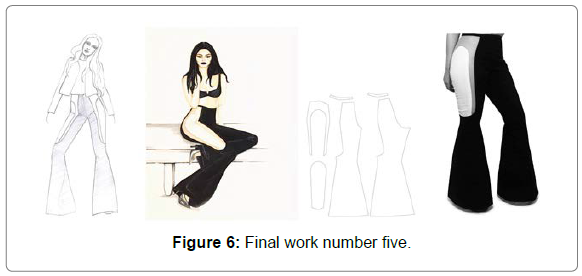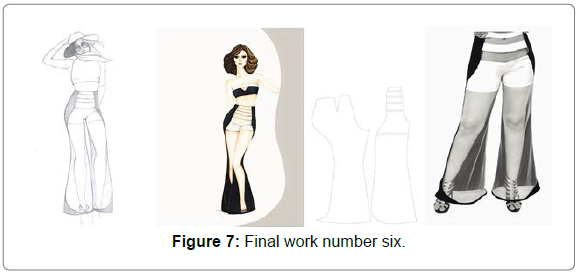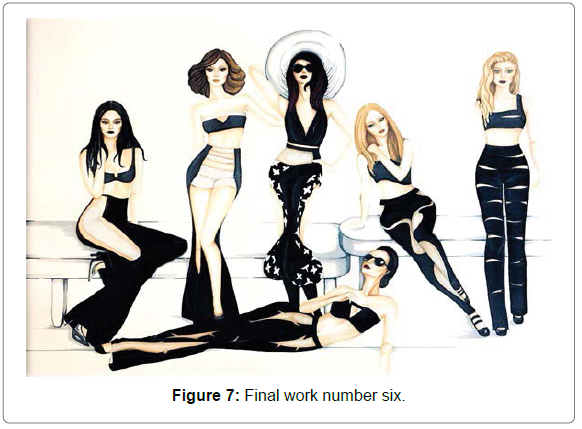Review Article, J Fashion Technol Textile Eng Vol: 9 Issue: 10
Design of Women's Pants Based on the Pants Silhouettes (Case Study: 19th Century To The Present)
Farahnaz Mousavi*, Armin Ahramian Pour, Azadeh Mirjalili and Golnaz Radmehr
Department of Design and Clothing, Yazd Branch, Islamic Azad University, Yazd, Iran
- *Corresponding Author:
- Farahnaz Mousavi
Department of Design and Clothing, Yazd Branch, Islamic Azad University, Yazd, Iran
E-mail: mousavi.farahnaz@gmail.com
Received Date: October 04, 2021; Accepted Date: October 25, 2021; Published Date: November 01, 2021
Citation: Mousavi F, Pour AA, Mirjalili A, Radmehr G (2021) Design of Women’s Pants Based on the Pants Silhouettes (Case Study: 19th Century to the Present). J Fashion Technol Textile Eng 9:10. 223.
Copyright: © All articles published in Journal of Fashion Technology & Textile Engineering are the property of SciTechnol, and is protected by copyright laws. Copyright © 2021, SciTechnol, All Rights Reserved.
Abstract
Pants, which cover the feet and cover half of the body, are an important part of clothing. Among all the clothes, perhaps, women’s pants are the only cover that is not paid much attention to, and this is the reason for dealing with it, as well as personal interest in the types of pants silhouettes that influenced the choice of the subject of this research. In this regard, the study of the history of pants, especially in the 19th century, and the 20th century, when wearing pants became popular among women in this century, and the definition of silhouette, how it came into being and the factors influencing it, as well as dealing with different types Pants are essential.
In this article, the aim is to introduce and examine pants in different types of silhouettes in more detail. Also, the designs should be such that the pants are out of their simple and permanent form, so that along with a cover such as a skirt, pants are also selected as a suitable option in parties and gatherings.
Keywords: Women’s pants; Silhouette; 19th century; Fashion; Designing
Introduction
Pants are bifurcated garments for the lower half of the body. Pants may be cut to be straight legged, flared or pegged, with bottoms that may be narrow or wide, flared, or cuffed. Pants can be cut with a high waist or a low waist, with buttons or a zip fly. The Greeks viewed the wearing of trousers as something done by foreigners and females. Greeks ancient writing and artwork implicate women as the investors of trousers. And By the 6000 BC, become emblematic of foreign archers especially Scythians, Persians, and Amazons. Scythian warriors, both male, and female, from Central Eurasia, are depicted wearing tight-fitting trousers in Greek art.
The earliest existing pair of pants was found in China and dates to around 1000 BC - within 1000 years when it is believed horses were initially domesticated. Experts believe that the construction style of these garments was designed specifically for horseback riding rather than for warmth or protection from the underbrush [1].
In ancient Iran (from 550 BC to the Crusades) they wore trousers under their clothes (candys). Later the candys appears to have been replaced by a coat worn over trousers, surely the forerunner of today’s standard civil costume for men.
Over time, as cavalry became more and more important in warfare, trousers became prestigious attire for noble horsemen of the Roman Empire and for medieval European knights. The practicality and high social status of trousers spread to other males in the Western world.
The “Northern Barbarians,” as they called, wore a kind of drawers or breeches shaped and sewn, rather like tights and held close to the leg above the knee by cross-gartering of thongs or bands. Men wore breeches throughout medieval Italy, France, and England, as well as following the Norman conquest and in the mid-fourteenth century in Flanders and Germany, and during the Italian Renaissance. During the Renaissance, trunk hose were popular in Italy and France. Pockets in the pants were invented near the conclusion of the Second Henry period. In the seventeenth century, “Venetian pants” were introduced, which were below the knee. Men and women in Spain wore trousers with garments and cloaks that came in three styles: one that was long, straight, and somewhat tight; another that was loose and shaped like a hedge skirt; and finally, the hedge with a tight wrist. Trunk hose, as well as tight Venetian and French pants with multiple rows of horizontal puffs, became popular at this time. Spanish dress impacted these three types of pants used in England during the Elizabethan period. The “Rhinegrave,” or divided skirt, was popular in England throughout the seventeenth century, and subsequently evolved into servants’ pants [2].
As part of a mission to drag Russia into what he viewed as the modern world, Peter the Great issued a decree, in 1701, on modern clothing stating that upper-class men were to follow guidelines concerning attire; that was including trousers. This clothes replaced the previous style of floor-length caftans.
Long pants replaced knee-length pants after the French Revolution. Women used hose with slit dresses during the dictatorship, and later divided skirts were worn instead of underwear during the consular era, when thin dresses were popular. With the return of refugees and the spread of equestrianism, ladies began to wear knitted tights beneath their riding skirts. George IV commanded the wearing of long pants in post-Waterloo England. Before 1800, just two to three documentation for the Drawer or Pantalet (underpants) was seen; but, by 1820, it was being used by a considerable number of ladies.
The final victory for trousers over breeches in England was the rise of the popularity of the menswear suit as known today, heavily influenced by Beau Brummell in the early 1800s. Until the 1950s, Victorian England’s pants were long and tight, with the bottom gradually widening. The front pockets on the front of the pants became fashionable around 1845. During this time, the initial effects of the trouser ironing line, which became popular in the 1990s, were seen. In 1851, a New Yorker lady created a variety of women’s clothing by wearing loose oriental trousers under a dress or short skirt. Women wore this dress while cycling, and from 1890 to 1900, they wore puffy short skirts or pants with a tight coat, and the bloomer, which was a wide, short pair of pants worn under a knee-length short skirt and was considered a sporty dress. During the war, the absence of men forced women to take on new roles and responsibilities. Women wore working uniforms of blouses, overalls or trousers with caps in ammunition factories [3].
Horse rider women wore trousers that were long up to the ankles, wide at the knees, and thin from the knees down between the two world wars. Knee-length pants, which subsequently gave way to long, tight pants, became popular with the introduction of winter activities. Tight pants gave way to baggy pants, which eventually vanished. The “Oxford-bag” trousers, with a leg width of 60 cm, became fashionable in the 1920s. Pants that were gradually narrowing from top to bottom were replaced with baggy trousers by the end of the 1920s, and piles were added to the waist of the pants in the early 1930s. Then, between 1948 and 1958, black elastic pantyhose were on the market, which were later covered with knee-length Bermuda trousers. Knee-length pants, pleated long pants and Bermuda shorts also became popular for men. The silhouette and the components that form it, as well as the details and factors that can impact the silhouette, will be discussed in the following sections.
The silhouette of a garment is its outline or shape. The style of a garment or garment part results from its silhouette and other identifying characteristics. Silhouette is determined by the amount and location of fullness in the garment and the methods for controlling the fullness.
Silhouette is the shape or the outline of the clothing when worm. The basic shapes or silhouettes of each season can change suddenly or evolve slowly. Different combinations of shapes made by separate garments worn together lend style to the overall shape or silhouette of the outfit [4]. Straight Leg, Bell Bottoms, Baggies, Palazzo, Knickers, Gauchos, Stretch, Jodhpurs, Boot-Cut, Harem, Toreador are some of the pants silhouettes.
Pants are divided into numerous varieties based on their length, ranging from short to long: Boy shorts, Jamaican shorts, Bermudan shorts, Safari shorts, Walking shorts, Surfers, Deck, Clam Digger, Gaucho, Cropped, Seven-eights, Capri, Classic, Stirrup. Pant styles fall into three basic silhouettes no matter what the current fashion trends are: fitted, straight, and flared [5].
Shaping can be accomplished by darts or by dart equivalents or dart substitutes. Dart equivalents substitute for darts by incorporating shape into the garment in a variety of ways. Garments are made from flat fabrics shaped to fit the human body. To hang straight, garments should be cut on the straight of the fabric’s grain. They may be cut on the bias for special effects. The cost of the garments has an impact on the shaping methods used.
Seams, darts, gathers, and pleats may be used to shape the silhouette and create a horizontal or vertical illusion in the pant design. The silhouette is also influenced by style and fashion trends. The identifying characteristics of a garment determine its style [6]. Variations in silhouette, length, waistline, edge treatments, pockets, and decorative details result in different styles. Decorative details integral to the garment include tucks, pleats, creases, ruffles, bows, and tabs. Women’s ready-to-wear garments follow specific trend prediction. The trend forecast information indicates the new color palette, the new fabric trends, surface treatments, silhouettes and design details [7].
The Process of Performing Practical Work
The set of trousers that were designed and stitched during this project is based on the individuality, personality, and interests of the designer and collector of this research, as well as current fashion and trend, according to what was indicated above Figure 1.
Final Works
Number 1: The waves of the sea, as well as the idea of mixing shorts and pants, inspired these pants. These tight-fitting pants have a Tights-like silhouette. The color of these black pants and their length below the ankle has been considered to lessen the effect of these lines and also because they feature aesthetic elements with circular forms that can make a person look larger. However, the style of these pants will generally show the person’s natural silhouette. Knitted fabric and elastic lace are utilized in these pants (Figure 2).
Number 2: The lines and cuts on these pants are designed like pants No. 1, inspired by the waves of the sea, and the silhouette is inspired by the knickers silhouette form, to which a wrist is added and the lines and cuts are formed like pants No. 1. The silhouette form of these pants is such that it can show shorter height and make a person appear bigger, so vertical lines and cuts have been used to try to mitigate the effect of its design. The fabrics utilized in this design are stretch and elastic lace, and the colors are black and white (Figure 3).
Number 3: The lines and cuts on the leaves inspired these pants. These pants have a wide silhouette and the shape of flared pants, which were popular in the early nineteenth century and can make a person appear shorter, so the vertical lines on the front of the foot from top to bottom, as well as the height of the crotch and the waistline, are designed in this way to lessen the impact. The hue of these black pants was chosen to enhance the contrast between the color of the fabric and the color of the body, as well as to make the sharp lines designed on it more visible. Fastoni and elastic lace are the textiles utilized in these pants (Figure 4).
Number 4: These trousers have a silhouette influenced by lateeighteenth- century straight pants, with lines and cuts inspired by pants number three. The lines that appear vertically on the pants number 3 are employed horizontally in this design, making these lines inappropriate for persons who are not skinny and tall (independent of the silhouette). The black color of these pants was chosen to highlight the cuts. Crepe and lace body color fabrics were used in this design (Figure 5).
Number 5: This pair of pants was created with the intention of removing an uncommon element of the pants while remaining in an appropriate location. The flared pants’ silhouette is designed, and the vertical lines on the upper part of it can help to avoid the influence of the silhouette on making a person appear short. The colors chosen for this pair of trousers are white, black, and nude for neutrality, and white and black contrast is used to define the cuts designed on the pants. Suede and elastic lace were used to make these pants (Figure 6).
Number 6: These pants have a loon silhouette, which was popular in the second half of the twentieth century. The vertical lines on both sides neutralize the effect of horizontal lines, and the length of the shorts is such that it can show height, taller. Designed with the idea of combining shorts and pants and creating rhythmic lines on top of it, the vertical lines on both sides neutralize the effect of horizontal lines, and the length of the shorts is such that it can show height, taller. To distinguish between shorts and pants, this design uses basic white, black, and nude hues. Crepe and lace are the fabrics utilized in these pants (Figures 7 and 8).
Conclusion
Due to a scarcity of men in society during and after World War II, women left their houses and went to work in the community. Their presence at work necessitated comfortable attire. During the war, there was a scarcity of cloth, and it was a necessity. The usage of more comfortable and lighter clothing for women made clothes shorter and the silhouette of the clothes closer to the body, and as this trend continued, the pants that were previously worn under the clothes became part of the clothing. Separately, enter the wardrobe. Based on cultural trends and trend predictions, silhouettes become more frequent throughout time. Big or tiny, it all depends on where the loose and fullness is added, or whether it is decided that the loose and fullness is not in any part of the dress, or that it is balanced in some way. Small features, such as the pocket and the hardness of the cloth, can also affect the silhouette, even if they are minor. Pants are classified by their height, tightness, and width, as well as a combination of these factors. Those who are half-thigh tall or shorter or quite tall display height greater when grouped by height. And the rest of them are usually lesser in height. Pants that are excessively tight or too short are inappropriate for both overweight and underweight people. Loose-fitting pants give the impression of a lower stature. The trend of fashion across time reveals that humans in each age have preferred to expose their limbs in various ways, including naturally, exaggeratedly, and dully, depending on the attitude of the culture at the moment.
References
- Wilcox R Turner (1958) The mode in costume.
- Cunnington C W, Cunnington P (1992) The history of underclothes. Courier Corporation.
- Beck U, Wagner M, Li X, Durkin-Meisterernst D, & Tarasov P E (2014) The invention of trousers and its likely affiliation with horseback riding and mobility: A case study of late 2nd millennium BC finds from Turfan in eastern Central Asia. Quat Int 348: 224-235.
- Susan Brown (2012) Fashion: the definitive history of costume and style. DK Publishing, New York.
- Koester A W, Bryant N O (1991) Fashion terms and styles for women's garments.
- Hamilton W, Wright S E (2015) Making Perfect Pants. New Mexico State University, Cooperative Extension Service, College of Agriculture, Consumer and Environmental Sciences.
- Adrienne Mayor (2014) The Amazons: Lives and Legends of Warrior Women across the Ancient World. Princeton University Press.
 Spanish
Spanish  Chinese
Chinese  Russian
Russian  German
German  French
French  Japanese
Japanese  Portuguese
Portuguese  Hindi
Hindi 